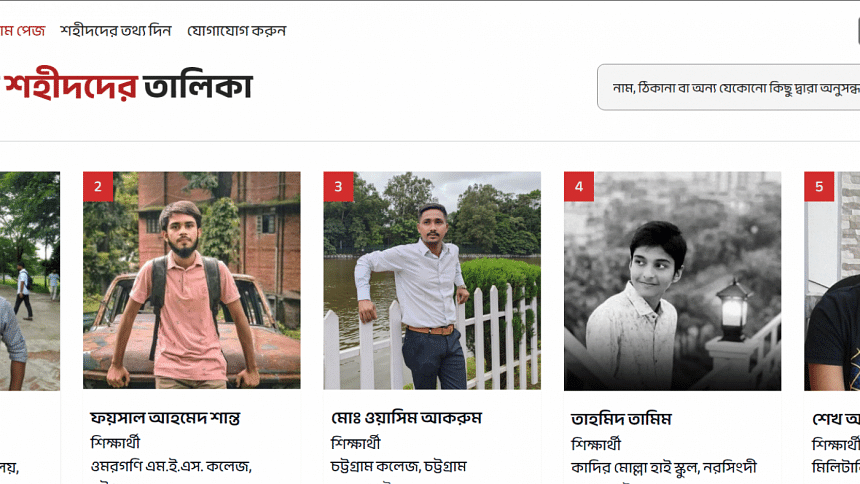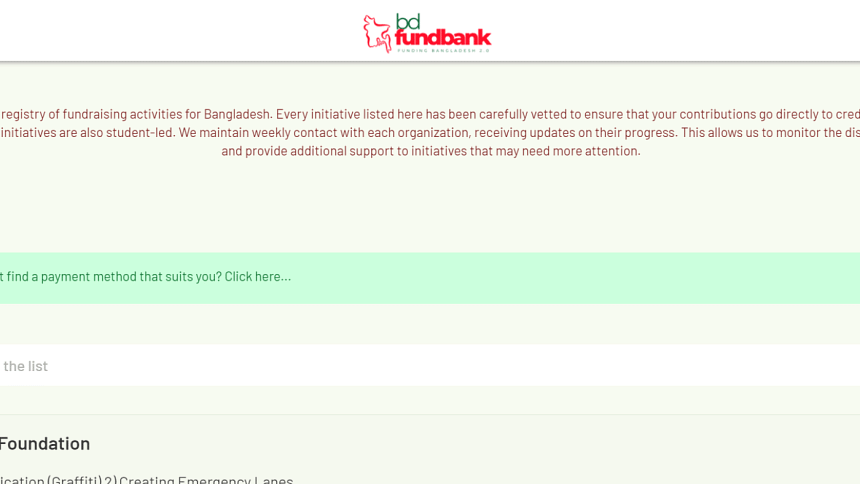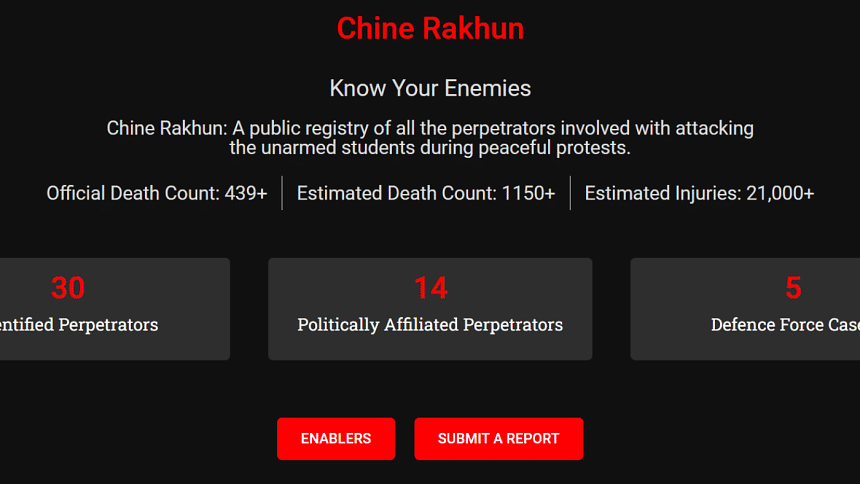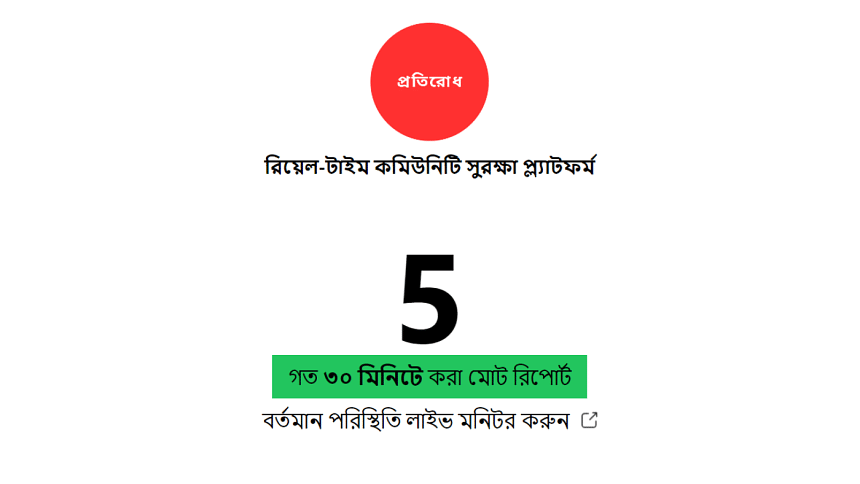The recent student-led movement that ousted Sheikh Hasina has been marked by an unprecedented fusion of activism and technology. As the youths took to the streets demanding justice and reforms, a new kind of resistance emerged amid internet crackdowns—one powered by digital tools and platforms, developed by the students themselves.
Shohid.info
As the protests continued, the movement's costs became increasingly apparent. Clashes with law enforcement led to numerous injuries, and tragically, many lost their lives. In the chaotic aftermath, misinformation spread rapidly, with conflicting reports about the number of casualties and the identities of those who had fallen. To counter this, Joshim Uddin launched Shohid.info. "As an expatriate, I was deeply concerned about my country," he shared.

"Over the past 15 years, more than 600 people have disappeared or been killed, yet we know very little about many of them as the government has erased nearly all the records. That is when I decided that I would not let them erase the memory of those who sacrificed their lives for this movement."
In the early days of the movement, Shohid.info relied on data gathered from Facebook posts shared by relatives and national newspapers. Joshim then invited the public to contribute information through a Google Form, receiving a positive response. As of now, the platform has published details on 200 martyrs and is working diligently to verify and release the remaining information.
Verification is a crucial step in ensuring the accuracy and reliability of the information and there is a dedicated team that cross-checks the data with shared Facebook posts, national newspapers, and information sent directly to them via messages and emails. "We are now creating a comprehensive timeline of the movement, documenting its origins and the various stages it has gone through. Our goal is to ensure an accurate historical record, free from any manipulation by external parties."
Additionally, they are developing a virtual museum related to the movement, which will feature items such as placards, slogans, graffiti, and photos. "We are also collaborating with several NGOs to provide information and support, helping them assist the families of martyrs and those injured," he added.
The Inquilab
Developed by Daniel Rozario, a student of Varendra University, and Minaruzzaman Shovon from Chittagong University of Engineering and Technology, The Inquilab serves as an archive of the news and stories of martyrs and key events of the protests. "I have seen so many things that we just forget after it happens. My goal was to organise the injustice happening to people for asking for their rights so we remember it later even if it fails. Never did I imagine that we would be successful in overthrowing the government," Daniel mentioned.
The platform uses Wayback Machine to ensure that these stories remain accessible over time. Looking forward, they aim to continue updating with relevant information, with plans to make the project more accessible and collaborative. "We will keep updating with any information I find relevant. Already added a public API so others can use this to make their own project. The project is already open-source, and we plan to make the database publicly available," he added.
Jogajog
When the government imposed an internet blackout that threatened to isolate protestors, cutting off their communication with each other and the outside world. Jogajog, a communication server , was designed in this crucial time by three students to keep the movement alive. "We believe the right to speak is essential to living and have always had the zeal to do something for the people of Bangladesh. When the internet blackout occurred, we feared losing all communication and information. We realised the need for a reliable, accessible, and encrypted communication medium, and that is how the idea emerged," explained Rafid Khan, a student of BRAC University. What started as an urgent response to the blackout quickly evolved into a lifeline for the movement.
However, the development was not without its challenges. The team faced significant obstacles, such as transferring files to the server without an internet connection and building a chat service from scratch. "With no internet access, we could not rely on resources like Google or StackOverflow, so we first built a basic chat service to communicate among ourselves. Using an old university project, we modified existing packages to create Jogajog," added Jaber Ahmed Deeder, a student of Bangladesh University of Engineering Technology (BUET).
The first version was built using NextJS with MySQL hosted locally on one of the team members' computers. Security was a top priority, with encryption algorithms developed to safeguard chats and user data. "A second version, created using PHP and ReactJS, introduced client-side caching, improved user experience, and additional security features like captcha and rate-limiting. Both versions ran simultaneously, with the second offering a smoother experience," mentioned Chowdhury Isfatul Karim, another student from BRAC University
BD Fund Bank
BD Fund Bank was a platform developed by Shamael Ahmed and Abrar Anwar to centralise and verify fundraising activities. The idea was born out of Shamael's frustration while living abroad during the protests, as she felt limited in how she could contribute. "I did what I could by spreading the word in my international community and donating to initiatives I found on social media, but I could not find anything more than that. Then one morning, I saw a fundraising post and was about to donate, only to realise I had already contributed to it. That is when the idea for BD Fund Bank came about," she explained.

As the protests intensified, there was a surge in fundraising initiatives, but these efforts were scattered. To address this, she began by compiling a database of trusted fundraising initiatives, initially gathering recommendations from her Facebook friends. Her efforts quickly gained traction, and she was soon joined by Abrar, who offered to build a website to house the database. "The real challenge with this site was to get it out as soon as possible so it could do the most for the initiatives out there. The point of this was not to create a ton of innovative new features—just to make something simple to help the students out there," he shared. The platform was built using a MERN stack, with a phased approach to continuously improve it based on user feedback.
Since its launch, BD Fund Bank has received an overwhelming response. The platform has also started collaborating with corporate entities like Hishabee, which has committed to donating 1% of revenue from subscription sales to initiatives listed on BD Fund Bank.
It currently functions as a dynamic registry of verified and vetted fundraising initiatives, with a search feature that allows users to find causes they are passionate about. "You can even search for things you are passionate about donating to, like 'Graffiti' or 'Minorities,' and the site will show you which initiatives are doing that," Abrar added.
Chine Rakhun
Shabab Junayed and Nur Mohammad Mamun developed Chine Rakhun, a platform dedicated to identifying and holding accountable those involved in attacking unarmed students. "When the students got attacked several times, most of us felt helpless. I wanted to do something that helps us identify attackers sooner or later. The primary goal is to bring everyone to justice who was involved with the attacks on unarmed students," Shabab explained.

The information about the perpetrators was gathered from various sources, primarily through social media and public submissions. Chine Rakhun has had a noticeable impact on the community, raising awareness about the individuals responsible for the attacks. "We have already expanded and created a separate section for people who were supporting the atrocities. The platform will continue to expand as we have plans to include people who are vandalising religious establishments and properties. We have received a huge number of submissions, and we are currently working on it," he further added.
Protirodh.net
Protirodh addressed a different but equally critical aspect of the newfound freedom – community safety. 'Protirodh', a real-time community safety platform, is designed to ease the process in which citizens are responding to and preventing crime, primarily through coordination groups on social media channels.
"I built this because I noticed a gap among the new generation of amazing volunteers who are patrolling every night and the general people in need of help. The primary purpose here was to ease the communication between these two groups and map out all the incidents around Bangladesh to quickly identify affected neighbourhoods so that volunteers would be able to reach these areas in time and respond promptly," explained Fahim Murshed.

The platform was developed in an incredibly short time frame. The founder described the rapid development process as a 'solo hyper-hackathon,' explaining that the focus was on getting the platform operational as quickly as possible. The platform offers users real-time incident reporting, with their location automatically pinpointed on a map. This enables swift response from law enforcement and volunteer groups. It features a dynamic map displaying reported incidents in real-time, allowing users to stay informed about their surroundings and potential risks.
The platform's accuracy and reliability were key concerns during development. To ensure that the alerts were both timely and credible, the founder implemented a system where the accuracy of alerts could be gauged by the number of separate reports emerging from a specific location. "I have also added a comment feature to each alert to update its status and made sure that the platform shows the crime reported in the last 30 minutes, which would help our community volunteers respond to the alerts as they are taking place instead of being misled by old alerts that have already been dealt with," he said.
In 24 hours since its publishing, Protirodh attracted approximately 190,000 active users, generating 1,800 reports across various categories after filtering out spam. Looking ahead, he has ambitious plans to include adding features for uploading pictures and videos to further authenticate alerts.
These initiatives illustrate how young people are not just participants in these movements, but also innovators, creating tools that amplify their impact and protect their communities. The story of these youth-led tech initiatives is not just a story of resistance—it is a story of resilience, creativity, and the enduring spirit of the students who simply refuse to be silenced.




Comments